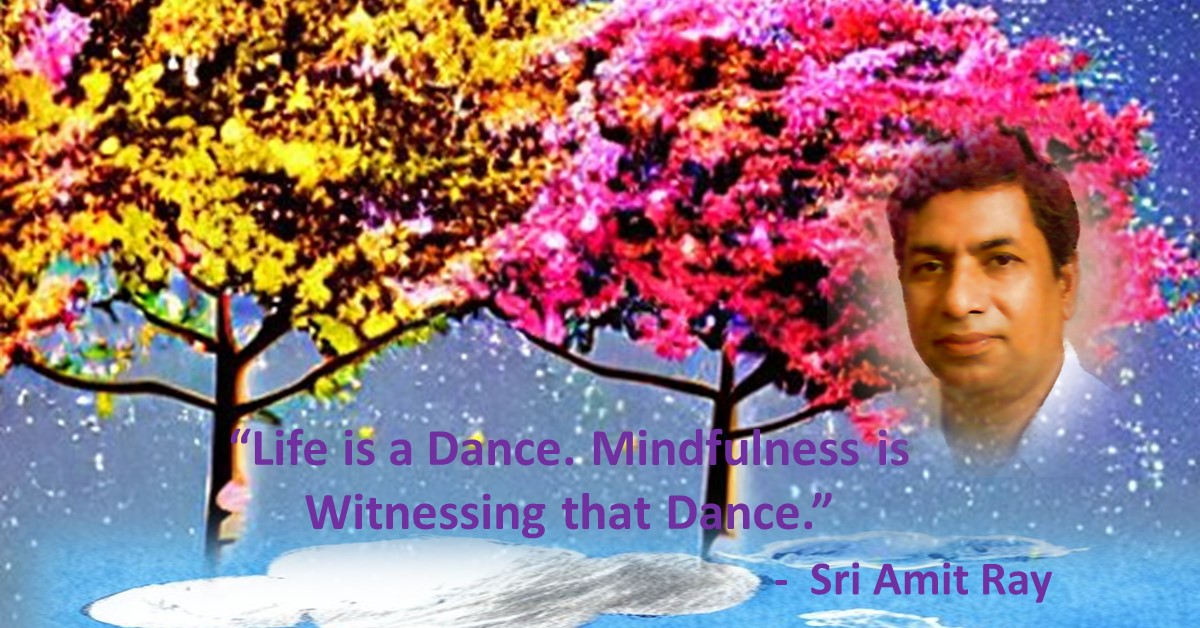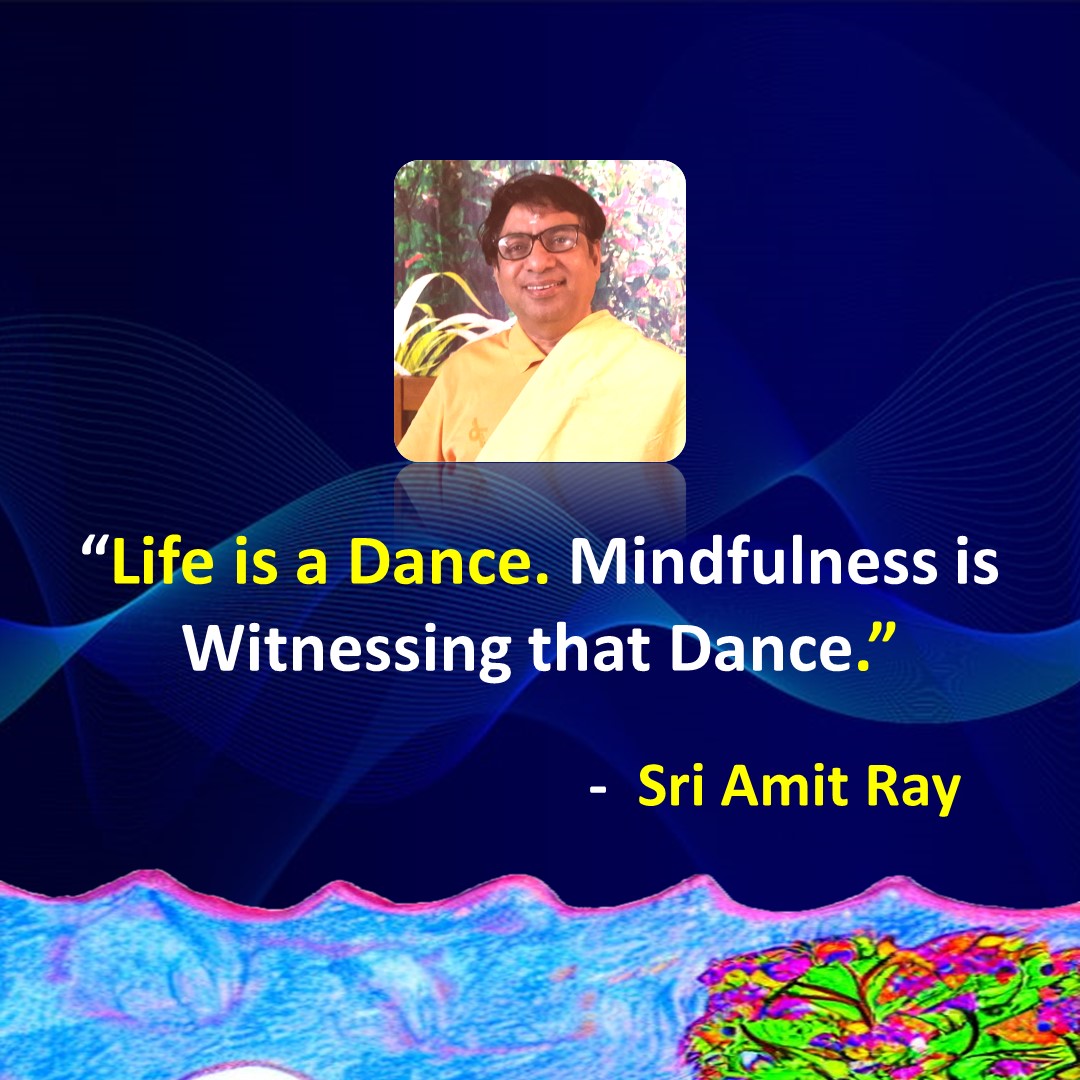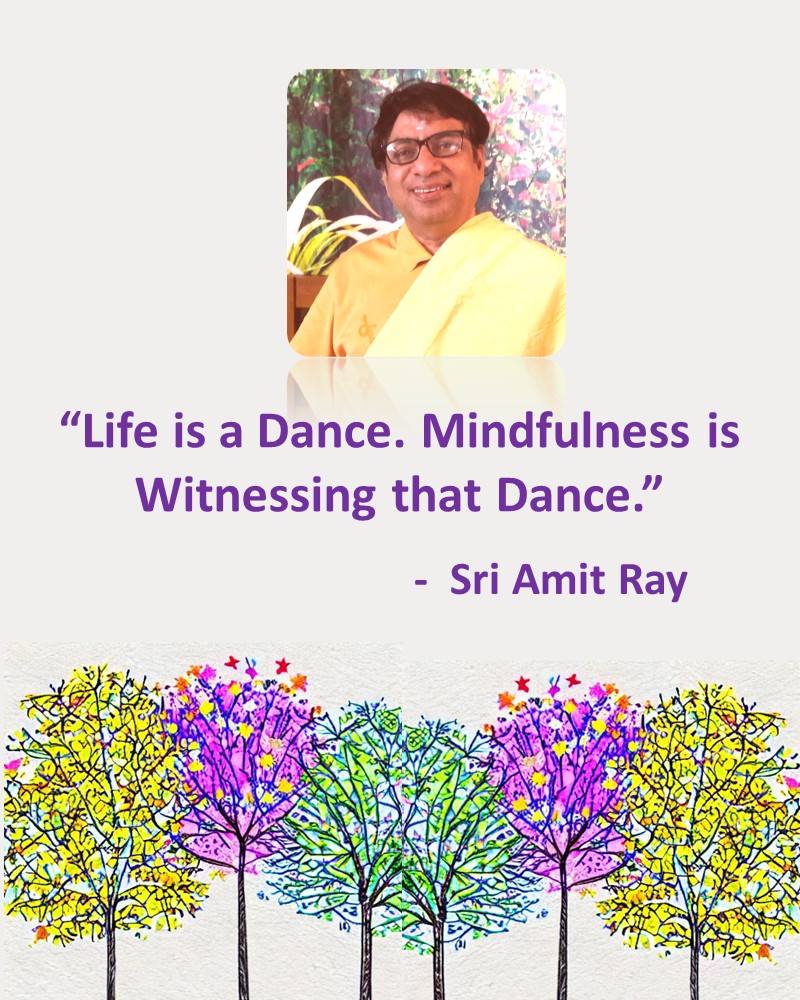Life has so many dances. The dances of breath, experiences of joy and sorrow, praise and criticism—”dance” is a magical term. It has so many meanings. Dance is everywhere. Lord Shiva’s cosmic dance symbolizes the essence of existence. Dance of the birds, dances of the tiny cells in the body. All are the signatures of divinity.
Mindfulness is recognizing the beauty of the universe’s pulses in our own heartbeats. Within the dance of higher spirituality, we find communion with the cosmos, uniting our individual rhythms with the heartbeat of the universe.

Imagine you are simply observing the rhythm of your breath. It has enormous capacity to rewire your brain. Imagine a peaceful moment in which you become a mute observer of your breath’s rhythmic dance. An extraordinary force takes root in this simple yet profound act of mindful witnessing. The gentle rise and fall of your breath has the extraordinary ability to rewire the intricate neural pathways in your brain, resulting in a profound inner transformation.
The dance of kindness heals wounds, the dance of words weaves the fabric of understanding, and the dance of behavior choreographs a world of grace and respect. In this quote, I emphasize the significance of mindfulness paired with witnessing, a potent duo that unveils the symphony of the universe residing within our very being.
“Dance of life has three components: expression, repetition of certain patterns, and rhythms. When you are mindful, you will know your rhythms, patterns, and expressions.” – Sri Amit Ray
In the flow of life in each moment we have so many experiences. Imagine life as an intricate dance performance, with each moment, experience, and emotion flowing seamlessly from one to the next. This dance encompasses the happiness, difficulties, and everything in between that we encounter in our journey. Just as a dancer performs on a stage, life unfolds on the stage of existence. Mindfulness, in this analogy, becomes the act of witnessing this dance, of being an attentive observer.
Here’s why mindfulness I often compared to witnessing this dance of life:
- Presence in the Moment: Just as a spectator in a theater focuses their attention on the performance before them, mindfulness encourages us to be fully present in each moment. It invites us to let go of distractions, worries, and preoccupations, and to direct our awareness to the present experience. By witnessing the dance of life in this way, we connect with reality as it unfolds, without being consumed by regrets of the past or anxieties about the future.
- Non-Judgmental Observation: When we watch a dance performance, we do so without judgment. We may appreciate the skill, emotions, and artistry of the dancers without labeling their movements as “good” or “bad.” Similarly, mindfulness invites us to observe our thoughts, emotions, and sensations without passing judgment. We cultivate a sense of detachment from our experiences, allowing us to acknowledge them without being overwhelmed by them.

- Awareness of Change: A dance is characterized by its constant change – the fluidity of movement, shifts in tempo, and evolving expressions. Life, too, is marked by change, from fleeting moments of happiness to challenging times of struggle. Mindfulness enables us to witness these changes with equanimity, recognizing that just as a dance evolves, so does life. We learn to adapt and respond to these changes rather than react impulsively.
- Embracing the Whole Experience: A dance performance comprises a variety of movements, emotions, and expressions. Likewise, life encompasses a spectrum of experiences, both positive and negative. Mindfulness encourages us to embrace the entirety of our human experience, to be present for the highs and lows, and to acknowledge the full range of emotions without denying or suppressing them.
- Cultivating Gratitude: When we watch a beautiful dance, we often feel a sense of awe and appreciation for the artistry before us. Mindfulness fosters a similar sense of gratitude for the beauty and intricacies of life. By witnessing the moments of joy, love, and wonder, we learn to savor and appreciate them fully, cultivating a deeper sense of gratitude.
- Freedom from Identification: In a dance performance, we don’t become the dancers, nor do we become entangled in their roles. Similarly, mindfulness helps us detach from the roles and identities we often assume in our lives. We recognize that we are not defined solely by our thoughts, emotions, or roles, but rather, we are the conscious witnesses of these aspects.
- Conscious dance of life: As we embrace the dance of life, we partake in a grand ballet where every action, every thought, and every intention swirls together in a waltz of intricate patterns. Just as a dance performance requires practice and dedication, the dance of our lives demands mindfulness and self-awareness. Through this conscious dance, we transcend the boundaries of our own limitations, unfurling wings of imagination and innovation.
Neuroscience of Witnessing
Discover how mindful witnessing transcends passive observation, empowering us to engage with life’s intricacies. Evidence based research suggests that practicing mindfulness helps individuals regulate attention, thoughts, feelings, and behavior [2]. Unveil the connection between mindfulness and resilience, as neuroscience reveals the brain’s remarkable adaptability under the influence of this practice [3] [4]. Researchers observed that mindfulness improves resilience [5]. Witness the fusion of mindfulness and spirituality, guiding us on a journey of self-discovery and interconnectedness with the universe.
Witnessing the Dance of Joy and Sorrow
Joy and sorrow perform a duet in which each influences the intensity and significance of the other. Joy dances through our emotions, infusing our days with warmth and light, while sorrow moves with a poignant grace that teaches us the depths of our humanity. Our emotions are the performers in this intricate movement, gracefully conveying the stories of our lives.
Detachment invites us to step back from the intensity of our emotional responses, providing a vantage point from which we can navigate the dance more gracefully. It encourages us to cultivate resilience, adaptability, and a broader perspective that transcends the immediate whirlwind of emotions. This state of inner detachment empowers us to respond to life’s challenges with a centered mind and an open heart, enabling us to make conscious choices rather than being carried away by the currents of emotion.
Approaching Life with Mindfulness
When you approach life with mindfulness, you become attuned to the rhythms of your experiences, the patterns that shape your behavior and circumstances, and the ways in which you express yourself. This awareness empowers you to make conscious choices, navigate challenges, and embrace opportunities with greater clarity and intention.
By recognizing your rhythms, patterns, and expressions, you can live more authentically, make informed decisions, and experience a greater sense of connection with the world around you.
Summary:
In essence, the idea that “Life is a dance. Mindfulness is witnessing that dance” emphasizes the essence of mindfulness as a conscious, non-judgmental, and present-moment awareness of the unfolding experience. Lord Shiva’s cosmic dance symbolizes the essence of existence. Mindfulness is witnessing the beauty of the universe in our own heartbeats. It encourages us to step back from the stage of our lives and become the attentive observers of the dance, embracing each movement with grace and mindfulness.
